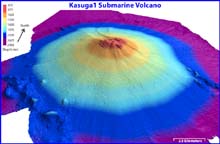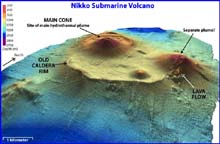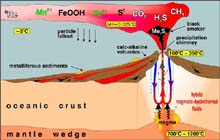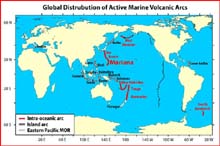
The Kasuga 1 submarine volcano is nearly a perfect cone, indicating it is relatively young and active. It is constructed from repeated eruptions from a small area at the summit. Click image for more information and larger view.
Submarine Arc Volcanoes
March 2, 2003
Gary Massoth, Marine Chemist
Institute of Geological and Nuclear Sciences, New Zealand
Bill Chadwick, Volcanologist
Oregon State University
Among the more than 50 submarine volcanoes we have surveyed during this expedition, we have found a wide variety of shapes and sizes, reflecting their different ages, life histories, and styles of eruption. The simplest volcanoes are nearly perfect cones, such as the Kasuga 1 Volcano. This shape is indicative of relatively young, active volcanoes and is constructed from repeated eruptions from a small area at the summit.
In contrast, other volcanoes, such as Nikko Volcano, have a more complicated shape and therefore a more complex eruptive history. Nikko Volcano has two summit cones, about 3 miles apart, that are on opposite sides of a broad summit plateau. This plateau appears to be the remnant of a large circular crater or caldera that has subsequently been filled by eruptive material. Thus, Nikko's lifetime has included large-scale collapse, rebuilding, and eruptions from more than one vent on the edifice.

Nikko submarine volcano has two summit cones within the remnant of a large circular caldera, which has been subsequently filled by eruptive material. Click image for more information and larger view.
Nikko is one of the volcanoes that we have found to be hydrothermally active during this expedition. At 800 meters (2,625 ft) in height and about 3.5 km (2.2 mi) in diameter at its base, Nikko is not a particularly large volcano. Yet Nikko, and several hundred other submarine volcanoes like it, may be far more important to the oceans than many scientists have previously thought.
The reason lies in the chemically rich and unusual fluids that can discharge into the oceans from this specific type of volcano—a submarine arc volcano. These unusual fluids are "exsolved" directly from water-rich magmas (molten rock) in the subsea floor (the same magmas from which many arc volcanoes are eventually built), and can be highly enriched in magmatic gases (e.g., carbon dioxide, hydrogen sulfide, sulpher dioxide) and metal-rich magmatic brines. They are called "magmatic fluids." The inclusion of even small fractions of these magmatic fluids into hydrothermal flowstreams (i.e., the hot fluids that commonly discharge near subsea-floor magma chambers at vents along the 60,000-km-long global system of ridgecrest spreading centers) can supercharge the transfer of many chemicals from the Earth’s interior to the oceans.

Schematic illustration of a venting system on a submarine arc volcano. These systems are driven by magma bodies that range in temperature depending on composition. Click image for more information and larger view.
While arcs with oceanic components stretch over 22,000 km globally (and about 20,000 km within the western Pacific basin), and contain more than 700 volcanoes ( more than 210 being submarine), they have not been considered important contributors to ocean chemistry until recently. However, the high frequency of venting along the small fraction of global arc length so far studied, and the magmatic, gas-rich signature that characterizes many arc plumes, suggest that arcs indeed may be important contributors to seawater chemistry. During this expedition, 20 percent of the 50 volcanoes systematically surveyed along about 1,000 km of the Mariana Arc have been found to be hydrothermally active.
This brings us back to Nikko Volcano, venting from its summit at about 400 m below the sea surface. While we will not know the full and exact chemical nature of the discharging fluids until pristine samples (i.e., vent fluids not mixed with seawater) are collected using a deep-sea sampling vehicle, the chemistry of the plumes we detected here clearly indicates a strong magmatic component.

Global distribution of active marine volcanic arcs. Click image for more information and larger view.
For example, about 2 micromoles (mM) of hydrogen sulfide (H2S) were measured in the plume above Nikko. If the samples collected were 10,000-fold dilutions of vent fluids, as is commonly found, then the hydrogen sulphide concentrations being discharged on the sea floor are about 20 mM, or higher than have been sampled at any mid-ocean ridge vent. Hence, Nikko is announcing to us an unusual and possibly very important aspect of arc volcano venting.

















